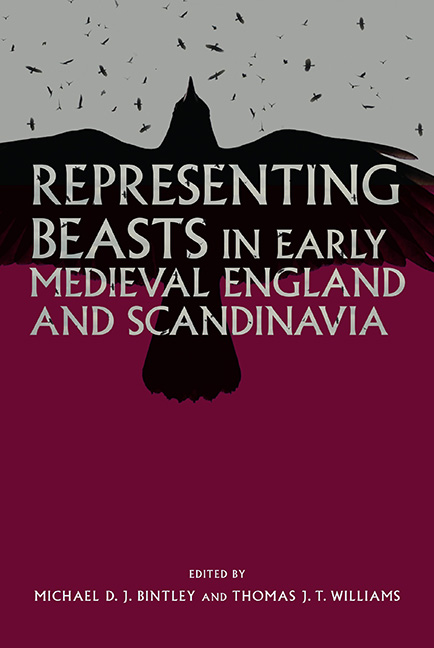Book contents
- Frontmatter
- Contents
- List of Figures and Tables
- Acknowledgements
- List of Contributors
- List of Abbreviations
- Introduction
- 1 Between Myth and Reality: Hunter and Prey in Early Anglo-Saxon Art
- 2 ‘(Swinger of) the Serpent of Wounds’: Swords and Snakes in the Viking Mind
- 3 Wreoþenhilt ond wyrmfah: Confronting Serpents in Beowulf and Beyond
- 4 The Ravens on the Lejre Throne: Avian Identifiers, Odin at Home, Farm Ravens
- 5 Beowulf’s Blithe-Hearted Raven
- 6 Do Anglo-Saxons Dream of Exotic Sheep?
- 7 You Sexy Beast: The Pig in a Villa in Vandalic North Africa, and Boar-Cults in Old Germanic Heathendom
- 8 ‘For the Sake of Bravado in the Wilderness’: Confronting the Bestial in Anglo-Saxon Warfare
- 9 Where the Wild Things Are in Old English Poetry
- 10 Entomological Etymologies: Creepy-Crawlies in English Place-Names
- 11 Beasts, Birds and Other Creatures in Pre-Conquest Charters and Place-Names in England
- Index
- Anglo-Saxon Studies
Introduction
Published online by Cambridge University Press: 11 June 2021
- Frontmatter
- Contents
- List of Figures and Tables
- Acknowledgements
- List of Contributors
- List of Abbreviations
- Introduction
- 1 Between Myth and Reality: Hunter and Prey in Early Anglo-Saxon Art
- 2 ‘(Swinger of) the Serpent of Wounds’: Swords and Snakes in the Viking Mind
- 3 Wreoþenhilt ond wyrmfah: Confronting Serpents in Beowulf and Beyond
- 4 The Ravens on the Lejre Throne: Avian Identifiers, Odin at Home, Farm Ravens
- 5 Beowulf’s Blithe-Hearted Raven
- 6 Do Anglo-Saxons Dream of Exotic Sheep?
- 7 You Sexy Beast: The Pig in a Villa in Vandalic North Africa, and Boar-Cults in Old Germanic Heathendom
- 8 ‘For the Sake of Bravado in the Wilderness’: Confronting the Bestial in Anglo-Saxon Warfare
- 9 Where the Wild Things Are in Old English Poetry
- 10 Entomological Etymologies: Creepy-Crawlies in English Place-Names
- 11 Beasts, Birds and Other Creatures in Pre-Conquest Charters and Place-Names in England
- Index
- Anglo-Saxon Studies
Summary
A man stands with arms raised, brandishing spears in both hands; he appears to be naked apart from a belt and a sheathed sword slung from a baldrick over one shoulder. His head is adorned by a helmet – or it might be a head-dress – from which rise two horn-like projections, each one terminating with the head of a bird, clearly delineated with eye and beak. The birds (the curl of their beaks suggests they are intended to be understood as raptors) face each other, curving inward until they overlap and form a circle above the spearman's clean-shaven face. To the right of this figure stands another apparition. He too holds a spear, thrust seemingly into the earth – or perhaps into the foot of his companion. He is drawing a sword with his right hand. This figure is clothed, perhaps even in armour, but a tail hangs down at his rear and his features are inhuman. He has the head of a beast.
Various overlapping interpretations have been offered for this striking image – it is Oðinn/Woden leading an ecstatic dance; a warrior in ritual transformation from man to wolf; a shaman enacting an initiatory rite; the dramatisation of a mythological scene. We will almost certainly never understand what message this image was truly intended to convey. What is clear, however, is that in this image the categories of beast and human are inextricably blurred, confused, confounded. Who here is the human? Which is the god, the animal, the hybrid? Does the naked spearman wear birds upon his head or do divine raptors control the body of a human puppet? Does a man wear a wolf's clothing, or does a wolf wear a man’s? It is precisely this sort of ambiguity in the representation of beasts and beast-identities that lies at the heart of this collection of papers.
The image on the cover of this book is a matrix of seventh-century date, found at Torslunda in Sweden, and designed for the production of panels of decorated metal ultimately destined for the ostentatious helmets of an élite warrior aristocracy. Objects bearing this style of iconographic display are exemplified by finds from the Swedish cemeteries of Vendel and Valsgärde, and also in similar objects from English contexts: the famous helmet from mound 1 at the Sutton Hoo cemetery in East Anglia, and fragments from the Staffordshire Hoard found in the West Midlands.
- Type
- Chapter
- Information
- Publisher: Boydell & BrewerPrint publication year: 2015

